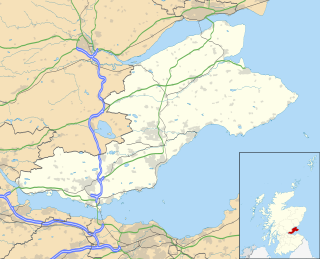Background
Robert Bruce was born in Clackmannan, Scotland the son of Thomas Bruce, 1st Baron of Clackmannan and his wife Marjory. Robert received more land in Clackmannan in 1359 from his cousin, King David II, and additional land in Rate, Scotland in 1367.
He married Isabel Stewart the daughter of Robert Stewart of Durisdeer, Dumfriesshire, with whom he had five sons and a daughter:
- Robert Bruce, 3rd Baron of Clackmannan;
- Edward Bruce, of Stenhouse, who married Agnes Airth, daughter of Sir William Airth of Airth, circa 1417.
- James Bruce, Bishop of Dunkeld [1]
- Alexander Bruce
- Thomas Bruce, of Wester Kennet (who had a charter for those and other lands on 2 May 1389); and
- Helen Bruce, who married David Ross of Balnagown. [2]
Robert was captured and killed on 23 July 1403, during the Battle of Shrewsbury, and his son Robert succeeded him as third baron.

Robert II was King of Scots from 1371 to his death in 1390. The son of Walter Stewart, 6th High Steward of Scotland, and Marjorie, daughter of King Robert the Bruce, he was the first monarch of the House of Stewart. Upon the death of his uncle David II, Robert succeeded to the throne.

Duke of Atholl, named after Atholl in Scotland, is a title in the Peerage of Scotland held by the head of Clan Murray. It was created by Queen Anne in 1703 for John Murray, 2nd Marquess of Atholl, with a special remainder to the heir male of his father, the 1st Marquess.

Earl Castle Stewart, in the County Tyrone, is a title in the Peerage of Ireland. It was created in 1800 for Andrew Thomas Stewart, 9th Baron Castle Stuart.

Earl of Elgin is a title in the Peerage of Scotland, created in 1633 for Thomas Bruce, 3rd Lord Kinloss. He was later created Baron Bruce, of Whorlton in the County of York, in the Peerage of England on 30 July 1641. The Earl of Elgin is the hereditary Clan Chief of Clan Bruce.

Lord Balfour of Burleigh, in the County of Kinross, is a title in the Peerage of Scotland. It was created in 1607 for Sir Michael Balfour.
Robert the Bruce (1274–1329) was King of Scots, Earl of Carrick and 7th Lord of Annandale; victor at the Battle of Bannockburn.

Clan Menzies ; Scottish Gaelic: Clann Mèinnear; a member is a Mèinnearach) is a Highland Scottish clan.

Clan Bruce is a Lowlands Scottish clan. It was a royal house in the 14th century, producing two kings of Scotland, and a disputed High King of Ireland, Edward Bruce.

Clan Drummond is a Highland Scottish clan. The surname is rendered "Druimeanach" in modern Scottish Gaelic.
George Douglas, 1st Earl of Angus (1380–1403) was a Scottish nobleman and peer.

Fingask Castle is a country house in Perth and Kinross, Scotland. It is perched 200 feet (61 m) above Rait, three miles (5 km) north-east of Errol, in the Braes of the Carse, on the fringes of the Sidlaw Hills. Thus it overlooks both the Carse of Gowrie and the Firth of Tay and beyond into the Kingdom of Fife. The name derives from Gaelic fionn-gasg: a white or light-coloured appendage.
Sir Thomas Bruce, 1st (feudal) Baron of Clackmannan(died before 1348) was the first Baron of Clackmannan.
Sir Robert Bruce, 3rd Baron of Clackmannan & Rate was the son of Sir Robert Bruce, 2nd Baron of Clackmannan & Rate and Isabel Stewart of Fife.
Alexander de Abernethy was a Scottish baron. He was a son of Hugh de Abernethy and Maria de Ergadia. Alexander was a descendant of abbots of Abernethy; his great-grandfather Laurence, great-grandson of Gillemichael, Earl of Fife, was the first to style himself Lord (dominus) His daughter Margaret married John Stewart of Bonkyll, the new Scottish earl of Angus.
Margaret Graham, Countess of Menteith was a Scottish noblewoman. She held the title Countess of Menteith in her own right, having inherited the title c. 1360 from her mother, Mary, Countess of Menteith, who was married to Sir John Graham. Graham was styled Earl of Menteith during his marriage with Mary, whom he predeceased. The Menteith region was situated partially in southwest Perthshire and partly in Stirlingshire.
James Drummond, 1st Baron Perth, was a Scottish soldier, landowner and peer.
Sir Robert Graham of Kinpont was a Scottish landowner, and one of the key conspirators in the assassination of King James I of Scotland in 1437.

Baron of Denboig is a title of nobility in the Baronage of Scotland in Fife.
There have been three baronetcies created for people with the surname Moncreiffe or Moncreiff, two in the Baronetage of Nova Scotia and one in the Baronetage of the United Kingdom. Two of the titles are dormant, as the heir has not proved his descent, and one is extant, though its holder does not bear the surname of Moncreiffe.

Alexander Elphinstone, 4th Lord Elphinstone (1552-1638), was a Scottish courtier, landowner, and Lord Treasurer.










